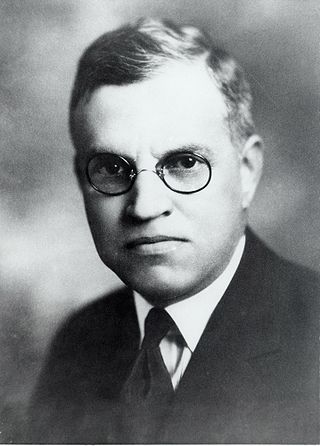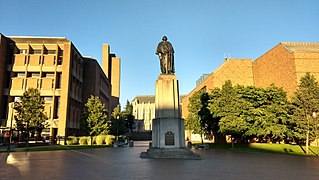
The Alaska–Yukon–Pacific Exposition, acronym AYP or AYPE, was a world's fair held in Seattle in 1909 publicizing the development of the Pacific Northwest. It was originally planned for 1907 to mark the 10th anniversary of the Klondike Gold Rush, but the organizers learned of the Jamestown Exposition being held that same year and rescheduled.

State Route 513 (SR 513) is a 3.35-mile-long (5.39 km) state highway in the U.S. state of Washington, located entirely within the city of Seattle in King County. The highway travels north as Montlake Boulevard from an interchange with SR 520 and over the Montlake Bridge to the University of Washington campus in the University District. SR 513 continues past University Village before it turns northeast onto Sand Point Way and ends at the entrance to Magnuson Park in the Sand Point neighborhood.

Klondike Gold Rush National Historical Park is a national historical park operated by the National Park Service that seeks to commemorate the Klondike Gold Rush of the late 1890s. Though the gold fields that were the ultimate goal of the stampeders lay in the Yukon Territory, the park comprises staging areas for the trek there and the routes leading in its direction. There are four units, including three in Municipality of Skagway Borough, Alaska and a fourth in the Pioneer Square National Historic District in Seattle, Washington.

Ravenna Park and Cowen Park comprise a single contiguous recreation and green space between the Ravenna and University District neighborhoods of Seattle, Washington in the United States. These public parks encompass the ravine with a maximum depth of 115 feet (35 m) through which Ravenna Creek flows.

John Galen Howard was an American architect and educator who began his career in New York before moving to California. He was the principal architect at several firms in both states and employed Julia Morgan early in her architectural career.

John Charles Olmsted was an American landscape architect. The nephew and adopted son of Frederick Law Olmsted, he worked with his father and his younger brother, Frederick Law Olmsted Jr., in their father's firm. After their father retired, the brothers took over leadership and founded Olmsted Brothers as a landscape design firm. The firm became well known for designing many urban parks, college campuses, and other public places. John Olmsted's body of work from over 40 years as a landscape architect has left its mark on the American urban landscape.

Robert Chambers Reamer (1873–1938) was an American architect, most noted for the Old Faithful Inn in Yellowstone National Park. A number of his works are listed on the National Register of Historic Places for their architecture.

The Nippon Kan Theatre is a former Japanese theater in Seattle, Washington, United States. It is located in the Kobe Park Building at 628 S. Washington Street, in the Japantown section of Seattle's International District.

University Way Northeast, colloquially The Ave, is a major street and commercial district in the University District of Seattle, Washington, located near the University of Washington (UW) campus. Once "a department store eight blocks long," The Ave has gradually turned into what now resembles an eight-block-long global food court. The story of The Ave reflects the dynamics of many urban neighborhoods and the social and economic problems of countless American cities, though it is also a crossroads of diverse subcultures. It is patronized by many of the nearly 96,900 students, faculty, and staff of the UW and by a population of homeless or transient individuals, most of whom are youth.

Bebb and Gould was an American architectural partnership active in Seattle, Washington from 1914 to 1939. Partners Charles Herbert Bebb and Carl Freylinghausen Gould were jointly responsible for the construction of many buildings on the University of Washington's Seattle campus, as well as the Seattle Times Square Building (1914), Everett Public Library, U.S. Marine Hospital, and the Seattle Art Museum building in Volunteer Park.

Samuel Hyde House is a building at 3726 East Madison Street in Seattle, United States listed in the National Register of Historic Places. The building, built in 1909–1910 for liquor magnate Samuel Hyde, housed the residence of the Russian consul-general from 1994–April 2018 when the US State Department evicted the consul-general following the White House ordered closure of Russia's Seattle consulate office.

The Federal Office Building, Seattle, Washington is a historic federal office building located at Seattle in King County, Washington.

Hotel Sorrento is an Italian oasis style hotel in Seattle, Washington, United States, located in the historic First Hill neighborhood.

The Grand Pacific Hotel is a historic building in Seattle, Washington, United States. It located at 1115-1117 1st Avenue between Spring and Seneca Streets in the city's central business district. The building was designed in July 1889 and constructed in 1890 [Often incorrectly cited as 1898] during the building boom that followed the Great Seattle Fire of 1889. Though designed as an office building, the Grand Central had served as a Single room occupancy hotel nearly since its construction, with the Ye Kenilworth Inn on the upper floors during the 1890s. The hotel was refurnished and reopened in 1900 as the Grand Pacific Hotel, most likely named after the hotel of the same name in Chicago that had just recently been rebuilt. It played a role during the Yukon Gold Rush as one of many hotels that served traveling miners and also housed the offices for the Seattle Woolen Mill, an important outfitter for the Klondike.

University Unitarian Church was designed by Seattle architect Paul Hayden Kirk in 1959. The church is located in the Wedgwood, Seattle neighborhood at the corner of 35th Avenue NE and 68th Street. The building is approximately a mile and half Northeast of the University of Washington Campus and sits across from the Northeast Branch of the Seattle Public Library. It was designed during the time when architect Kirk was working as a sole practitioner.

The Campus of the University of Washington is located in the University District of Seattle. Campus buildings are categorized by the major street or vicinity on which they are located on campus. In 2011, Slate magazine and Travel + Leisure described the Seattle campus as one of the most beautiful university campuses in the United States.
The Sourdough Inn, at First and Sled Streets in Fort Yukon, Alaska, was built in 1926, by moving a disused Army building from Fort Egbert near Eagle, Alaska. It was then modified and opened as a hotel. It has also been known as the New Sourdough Hotel and has served as a restaurant, a hotel, a post office and, briefly in the 1940s, as a school.

Drumheller Fountain is an outdoor fountain on the University of Washington campus in Seattle, Washington, in the United States. The fountain was given its name in 1961 to honor the University Regent Joseph Drumheller, who gifted the central fountain machinery to the University for its centennial celebration.

The Montlake Historic District is a part of Montlake, located northeast of the downtown district in Seattle, Washington that has been listed on the National Register of Historic Places since October 15, 2015. It primarily contains residential property. However, there are some other types of buildings within the district such as the Northwest Fisheries Science Center of the National Marine Fisheries Service and the Seattle Yacht Club.



















